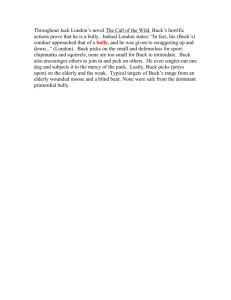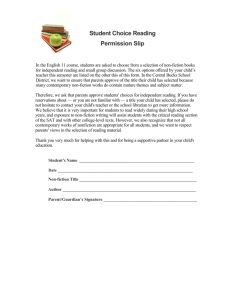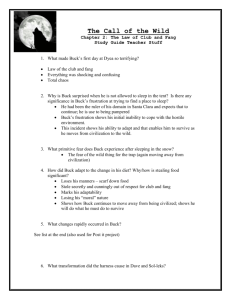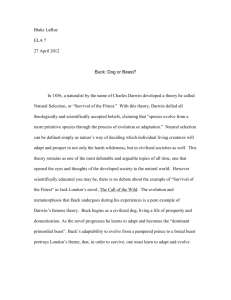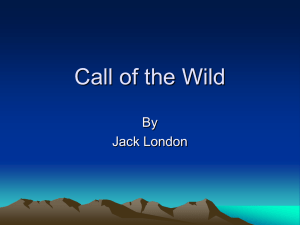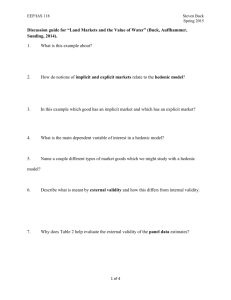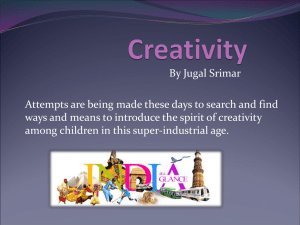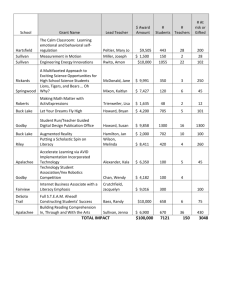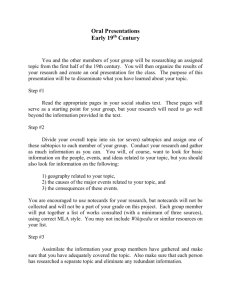Lesson Design
advertisement
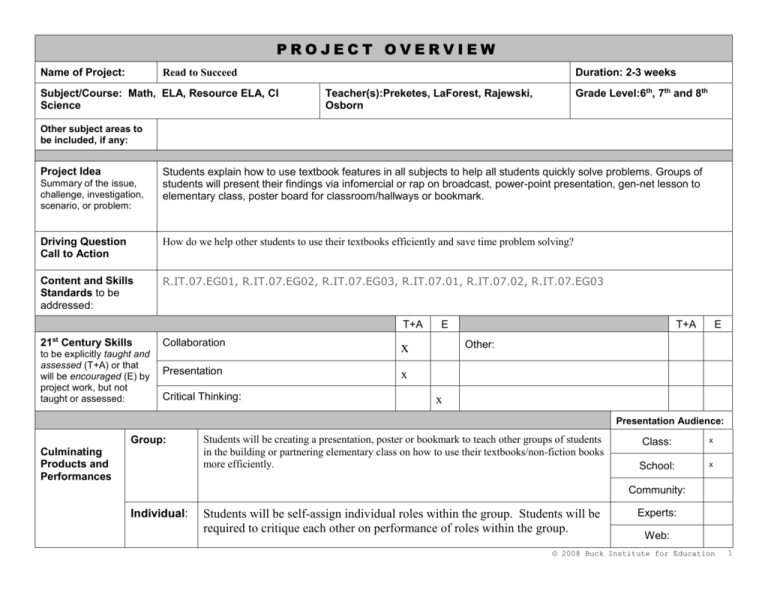
PROJECT OVERVIEW Name of Project: Duration: 2-3 weeks Read to Succeed Subject/Course: Math, ELA, Resource ELA, CI Science Grade Level:6th, 7th and 8th Teacher(s):Preketes, LaForest, Rajewski, Osborn Other subject areas to be included, if any: Project Idea Summary of the issue, challenge, investigation, scenario, or problem: Students explain how to use textbook features in all subjects to help all students quickly solve problems. Groups of students will present their findings via infomercial or rap on broadcast, power-point presentation, gen-net lesson to elementary class, poster board for classroom/hallways or bookmark. Driving Question Call to Action How do we help other students to use their textbooks efficiently and save time problem solving? Content and Skills Standards to be addressed: R.IT.07.EG01, R.IT.07.EG02, R.IT.07.EG03, R.IT.07.01, R.IT.07.02, R.IT.07.EG03 T+A 21st Century Skills to be explicitly taught and assessed (T+A) or that will be encouraged (E) by project work, but not taught or assessed: Collaboration x Presentation x Critical Thinking: E T+A E Other: x Presentation Audience: Group: Culminating Products and Performances Students will be creating a presentation, poster or bookmark to teach other groups of students in the building or partnering elementary class on how to use their textbooks/non-fiction books more efficiently. Class: x School: x Community: Individual: Students will be self-assign individual roles within the group. Students will be required to critique each other on performance of roles within the group. Experts: Web: © 2008 Buck Institute for Education 1 Other: PROJECT OVERVIEW Entry event to launch inquiry, engage students: To give students a problem in an envelope that requires them to use non-fiction text to develop the solution. Debrief on the challenges of the problem and what was useful to helping you solve the problem. Assessments Formative Assessments (During Project) Quizzes/Tests Practice Presentations Journal/Learning Log Notes Preliminary Plans/Outlines/Prototypes x Checklists Rough Drafts x Concept Maps Online Tests/Exams Other: Written Product(s), with rubric: Other Product(s) or Performance(s), with rubric: Summative Assessments __________________________________________________ __________________________________________________ (End of Project) Oral Presentation, with rubric x x Peer Evaluation Multiple Choice/Short Answer Test Self-Evaluation Essay Test Other: x . Resources Needed On-site people, facilities: Equipment: Materials: Media Center, Media Specialist Gen-net Lab, Video Cameras, Computer Lab Textbooks, Posters, Markers, Manuals, Magazines Community resources: © 2008 Buck Institute for Education 2 Reflection Methods (Individual, Group, and/or .Whole Class) Journal/Learning Log x Focus Group Whole-Class Discussion x Fishbowl Discussion Survey Other: © 2008 Buck Institute for Education 3 PROJECT TEACHING AND LEARNING GUIDE Project: Course/Semester: Knowledge and Skills Needed by Students to successfully complete culminating products and performances, and do well on summative assessments Must have knowledge of textbook features and vocabulary. Scaffolding / Materials / Lessons to be Provided by the project teacher, other teachers, experts, mentors, community members Collaborative team building skills. Examples of non-fiction, fiction text. Real world examples (i.e. instruction manual, websites, etc.) Teampedia.net, Learning Profile Cards Communication Rubrics, peer-assessment, self-assessment, team building, modeling, gallery walk Rubrics, peer-assessment, teacher-developed problems/student-developed solutions Critical thinking (compare/contrast) Creativity Presentations Lesson to elementary students (GenNet), skit, rap, posters, powerpoint, bookmark, infomercial, PSA, broadcast - Online survey!!! © 2008 Buck Institute for Education 4 P R O J E C T Project: Read to Succeed M O N D A Y C A L E N D A R Start Date: 9/12/11 T U E S D A Y W E D N E S D A Y T H U R S D A Y F R I D A Y PROJECT WEEK ONE Team Building Activity: Pass the “rock” Learning Profile Cards Students take a learning profile survey to identify strengths and weaknesses. Entry Activity: Present students with real world based problem in an envelope. Students will solve using a manual or magazine. Students complete problem solving worksheet. Students chose groups to work with on solving their problems (3-5 students per group depending on class size). Introduce Driving Question Team Building Activity: Follow/Find the leader Choose groups: Student choice, with some teacher input Introduce Final Projects Students get into groups Students get into groups. Fiction v Non-Fiction (compare/contrast) Give groups a variety of fiction and non-fiction texts. Students are to complete a Venn Diagram or T-Chart comparing the two types of texts. Then debrief. Review DQ and final project options. Groups pick one. Give Students final project options and time to pick a project. Students complete Project Team Work Plan Non v Non-Fiction Give groups a variety of non-fiction texts. Students then complete a Venn Diagram or TChart comparing the different types of nonfiction texts. Then Debrief. © 2008 Buck Institute for Education 5 PROJECT WEEK TWO Interactive PowerPoint discussing text-features Students get into their groups Project Development Day Textbook Hunt with class’ textbook Reflection Log on how your group is doing Assessment: knowledge of text feature vocabulary. Project Development Each group will complete the textbook hunt using their textbook. Groups will become more familiar with formal text vocabulary that was discussed in the previous days’ lesson. Gallery Walk Groups will present project ideas on chart paper. (sample of bookmark, script, rap, poster etc). These will be displayed around the room. Groups will walk around the room and leave reflective comments. PROJECT WEEK THREE Review Comments from Gallery Walk Project Development Review DQ Project Development Presentations Celebration Practice Presentations Vote for projects to be on broadcast and GenNet. Debriefing: Project Development FINAL PRESENTATION DISTRIBUTION FINAL PRESENTATION DISTRIBUTION GenNet PowerPoint/Broadcast FINAL PRESENTATIONS DISTRIBUTION Students complete “My Thoughts about the project” reflection sheet. FINAL PRESENTATIONS DISTRIBUTION © 2008 Buck Institute for Education 6 © 2008 Buck Institute for Education 7 Lesson Design: Checkpoints: Careful construction of lessons to remove barriers and provide assess for all students. Includes On the first day of the project students are going to be taking learning profile surveys to help them gain an understanding of themselves as a learner. This will highlight their strength areas and help them to see they are a valuable member of the classroom. Multiple ways to represent information Many of the activities are to be completed as a team. This allows students access to peers if they are struggling with an activity/concept. They will be required to have discussions within their group to help make clarify new concepts. Support provided for text comprehension Students are going to be given three choices for their project. This allows students to pick the project that allows them to play to their particular strengths. Students are going to be provided with an example of a completed “Project Team Work Plan” specific for the project they have picked. This will allow students to see an example of what needs to be completed in order to be successful with the project. Groups will then fill in their own “Project Team Work Plan”. The definitions of the different text features are going to be delivered via an interactive PowerPoint. This PowerPoint provides real world examples and questions after every section allowing for immediate feedback. Alternatives to text Flexible technologybased materials, strategies and tools Multiple ways for students show what they know Conspicuous supports for learning new strategies Mechanism for rapid feedback to learners Active student-centered methods Choice, Challenge, Novelty Connected, relevant learning © 2008 Buck Institute for Education 8 RUBRIC FOR Understanding Text Features 2 CATEGORY Contributions 4 3 1 Routinely provides useful ideas when participating in the group and in classroom discussion. A definite leader who contributes a lot of effort. Usually provides useful ideas when participating in the group and in classroom discussion. A strong group member who tries hard! Sometimes provides useful ideas when participating in the group and in classroom discussion. A satisfactory group member who does what is required. Rarely provides useful ideas when participating in the group and in classroom discussion. May refuse to participate. Quality of Work Provides work of the highest quality. Provides high quality work. Provides work that occasionally needs to be checked/redone by other group members to ensure quality. Provides work that usually needs to be checked/redone by others to ensure quality. Attitude Never is publicly critical of the project or the work of others. Always has a positive attitude about the task(s). Rarely is publicly critical of the project or the work of others. Often has a positive attitude about the task(s). Occasionally is publicly critical of the project or the work of other members of the group. Usually has a positive attitude about the task(s). Often is publicly critical of the project or the work of other members of the group. Often has a negative attitude about the task(s). Working with Others Almost always listens to, shares with, and supports the efforts of others. Tries to keep people working well together. Usually listens to, shares, with, and supports the efforts of others. Does not cause "waves" in the group. Often listens to, shares with, and supports the efforts of others, but sometimes is not a good team member. Rarely listens to, shares with, and supports the efforts of others. Often is not a good team player. Text Features Has identified most of the text features. Has identified some of the text features. Has identified a few of the text features. Has difficulty identifying any of the text features. Presentation Has presented material effectively. Has presented material with most of the content. Has presented material with some of the content. Has difficulty presenting the material. Reflection Was able to describe accurate detailed reflection of the project. Was able to describe most of the details of the project. Was able to describe some of the details of the project. Has difficulty describing details of the project. © 2008 Buck Institute for Education 9 © 2008 Buck Institute for Education 10
